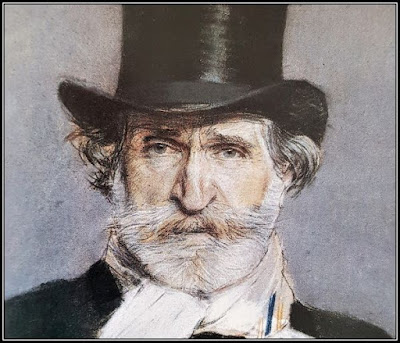Giuseppe Fortunino Francesco Verdi was born in 1813 in Le Roncole, a very small village in the northern Italian province of Parma, near Busseto. His parents maintained the village's only shop, but they were poor and uneducated and never learned to write or read. Their son must have shown his musical talent early, because his parents bought him a spinnet (small harpsichord) and at 12 years old he was already an organist in the village church.
 |
The house where Verdi was born,
in the village of Le Roncole. |
Fortunately for
Verdi, one of his father's suppliers, Antonio Barezzi, was a wealthy merchant and philanthropist. He lived in the neighbouring town of Busetto where he took over the supervision of Giuseppe's music education.
The boy lived there as a boarder and learned to play flute, bass clarinet, horn and piano. On Sundays he walked barefoot to Le Roncole to perform the duties of ecclesiastical organist.
At eighteen, Verdi applied to register at the Milan Conservatory, but was rejected because he had exceeded the normal age of registration. However, Barezzi rushed to help and took over the costs of his studies in Milan. After that Verdi returned to Busetto and although he was not yet 23 years old, he married the daughter of his protector, Margherita.
Success and tragedy
Verdi tasted the first success in 1839, when he managed to convince La Scala Theatre to put on his first opera, Oberto. The success was immediate and he was commissioned to write three more operas.
But fate struck tragically. In 1838 his two young children died one after the other and in 1840, his
 |
Verdi's first wife, Margherita Barezzi.
Verdi loved her too much and her death,
at a young age, crushed him. |
beloved young wife died suddenly of some mysterious illness. Verdi was devastated and it is no wonder that his second opera,
Un Giorno di Regno (A Day of Reign), was not a success.
Fortunately, in his misery he found a supporter, the director of La Scala, who asked him to set a libretto that referred to the biblical history of the captivity of the Jews by the Nebuchadnezzar. The result was the Nabbuco opera, which was first presented in 1842 and made Verdi famous overnight.
In the sweat shop
Within a very short time, Verdi became famous throughout Europe and started the business that he called "my life in the sweat shop", i.e. writing on demand offering what the audience was asking for. In the years between 1842 and 1851 he composed 14 operas and although few of them were truly remarkable, he at least gained wealth and established his reputation. In the early 1850s there appeared a major shift in Verdi's career with the composition of three of his greatest operas - the 1851
Rigoletto,
Il Trovatore and
La Traviata in 1853.
It was in the same decade that Verdi began to identify with the italian unification (Risorgimento). His name was used as a patriotic war cry, and "Viva Verdi" ("Long live Verdi") was carved into the walls. The Austrians, who ruled parts of Northern Italy at the time, did not realize that the world was not just exasuring its great composer, but was using the letters of his name as the initials for the name of the man he wanted for his king - Vittorio Emmanuele Re d'Italia (Vittorio Emmanuelle King of Italy). Meanwhile, Verdi's personal life has stabilized. He had met the singer Clelia Maria Joseph’s (Guiseppina) Strepponi and already in 1849 they lived together as a couple. They finally got married in 1859.
A selection issue
By about 1860, Verdi had ceased to compose to order. His next operas were written because he wanted to write them.
Don Carlos, for example, it was the challenge of the "great opera" and the themes of Schiller's famous work that inspired him.
 |
Giuseppina Strepponi, the singer who
gave happiness to Verdi. The couple
married in 1859. |
From 1873 to 1885, Verdi did not composed any operas. Then surprisingly, at the age of 72, he began composing a new opera, Otello, into a libretto based on Shakespeare's work. It was a musical feast, a work infinitely melodic. But there was more. Arrigo Boito, Otello's brilliant poet and librettist, was now working on The Merry Wives of Windsor, Shakespeare's. So at the age of 80, Verdi created his latest masterpiece, Falstaff, a comic opera of great lyrical beauty.
In 1897, Giuseppina died of pneumonia at the age of 82. Verdi then lived in Milan, where he died in early 1901. He left instructions, his funeral to be simple without music and songs. But that didn't stop the crowding outside milan's cemetery from suddenly and spontaneously starting - at first very slowly and then louder - singing the amazing choral from Nabucco.




Comments
Post a Comment